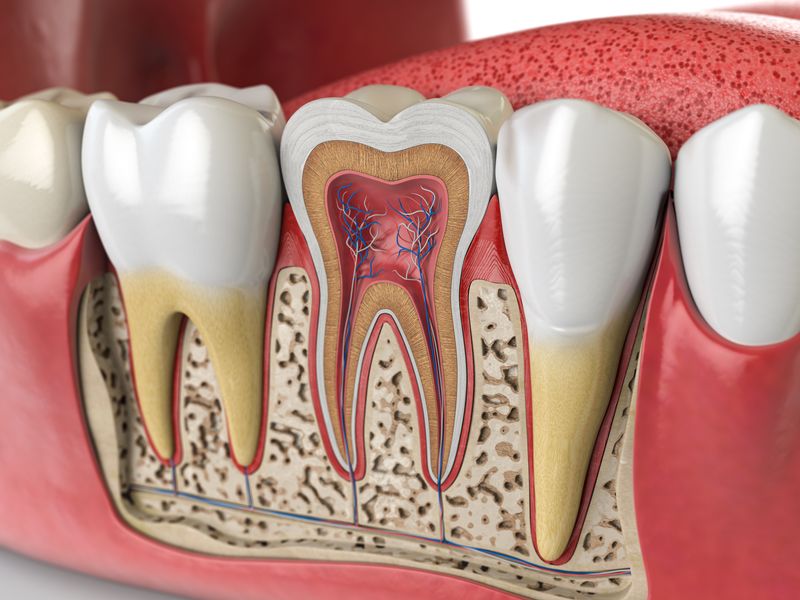Say Goodbye to Tooth Pain: How Root Canal Treatment Can Save Your Smile

Say Goodbye to Tooth Pain: How Root Canal Treatment Can Save Your Smile
Are you tired of living with constant tooth pain? Say goodbye to those sleepless nights and discomfort while eating with the help of root canal treatment. This revolutionary dental procedure is designed to save your smile and eliminate the source of your dental agony. Root canal treatment is a safe and effective way to remove the infected pulp from your tooth, providing immediate relief and restoring your oral health. In this article, we will delve into the world of root canal treatment, exploring its benefits, procedures, and what to expect during and after the treatment. Whether you have been suffering from a toothache for weeks or just recently started experiencing dental discomfort, this article will guide you through the process of getting a root canal and help you regain your beautiful smile. Don’t let tooth pain hold you back any longer – read on to discover how root canal treatment can be the solution you’ve been searching for. Call us on 07 3269 2443 or Book Online
Understanding root canal treatment
Root canal treatment, also known as endodontic therapy, is a dental procedure that involves removing the infected pulp from the inside of a tooth. The pulp is the soft tissue found in the center of the tooth, which contains nerves, blood vessels, and connective tissue. When the pulp becomes infected or inflamed due to tooth decay, trauma, or other factors, it can lead to severe tooth pain and potential tooth loss if left untreated.
During a root canal treatment, the dentist will create a small opening in the tooth to access the infected pulp. The infected pulp is then carefully removed, and the inside of the tooth is cleaned and disinfected. Once the tooth is free from infection, it is filled with a rubber-like material called gutta-percha to seal the canal and prevent reinfection. In most cases, a dental crown is placed on top of the treated tooth to provide additional strength and protection.
Root canal treatment is a highly successful procedure, with a success rate of over 95%. It not only saves the affected tooth from extraction but also eliminates the source of the pain, allowing you to enjoy a pain-free and healthy smile.

Causes of tooth pain and when root canal treatment is necessary
Tooth pain can have various causes, including tooth decay, gum disease, tooth abscess, cracked tooth, or trauma. However, not all tooth pain requires root canal treatment. In general, root canal treatment is necessary when the pulp becomes infected or inflamed due to advanced tooth decay, deep cavities, repeated dental procedures on the same tooth, or a cracked or fractured tooth.
The most common symptom of a tooth in need of root canal treatment is persistent toothache, which can range from mild to severe. Other signs that indicate the need for a root canal include sensitivity to hot or cold temperatures, pain while chewing or biting, swollen gums, a small bump on the gums, or discoloration of the affected tooth. If you are experiencing any of these symptoms, it is important to visit a dentist as soon as possible for an evaluation.
The process of root canal treatment
Root canal treatment typically requires one or more visits to the dentist, depending on the complexity of the case. During the first visit, the dentist will examine the affected tooth, take an x-ray to assess the extent of the infection, and determine if root canal treatment is necessary.
If root canal treatment is recommended, the dentist will administer local anesthesia to numb the area around the tooth. This ensures that you are comfortable and pain-free throughout the procedure. Once the anesthesia has taken effect, the dentist will create a small access hole in the tooth to reach the infected pulp.
Using specialized instruments, the dentist will carefully remove the infected pulp from the tooth’s root canals. The canals are then cleaned and shaped to prepare them for filling. To prevent reinfection, the canals are filled with gutta-percha, a biocompatible material that seals the tooth and prevents bacteria from entering.
After the root canal treatment, a temporary filling is placed on top of the tooth to protect it until a permanent dental crown can be placed. The dental crown not only restores the tooth’s appearance but also provides strength and protection, allowing you to bite and chew normally.

Benefits of root canal treatment
Root canal treatment offers several benefits, making it an excellent solution for saving a tooth and relieving tooth pain. Some of the key
benefits include:
1. Pain relief: Root canal treatment eliminates the source of tooth pain by removing the infected pulp, providing immediate relief.
2. Tooth preservation: Rather than extracting the affected tooth, root canal treatment allows you to keep your natural tooth, maintaining your oral health and preventing the need for costly tooth replacement options.
3. Improved oral health: By removing the infected pulp and sealing the tooth, root canal treatment restores the health of the tooth and prevents the spread of infection to neighboring teeth or other parts of the body.
4. Aesthetics and functionality: With the placement of a dental crown, root canal-treated teeth are restored to their natural appearance, allowing you to smile, eat, and speak with confidence.
5. Cost-effective: Root canal treatment is generally more cost-effective in the long run compared to tooth extraction followed by tooth replacement options like dental implants or bridges.
Common misconceptions about root canal treatment
Root canal treatment has long been associated with pain and discomfort, leading to several misconceptions about the procedure. However, it is important to separate fact from fiction when it comes to root canal treatment. Here are some common misconceptions debunked:
1. Root canal treatment is painful: Thanks to modern advancements in dental technology and anesthesia, root canal treatment is no more painful than getting a routine dental filling. In fact, the procedure is designed to alleviate tooth pain and provide relief.
2. Extraction is a better option: Saving your natural tooth through root canal treatment is almost always the best option. Extracting a tooth can have long-term consequences on your oral health, including shifting of teeth, bite problems, and bone loss.
3. Root canal treatment causes illness: There is no scientific evidence to support the claim that root canal treatment causes systemic illnesses. The procedure is safe and effective when performed by a skilled dentist.
How to prepare for a root canal treatment
Preparing for a root canal treatment involves a few simple steps to ensure a smooth and successful procedure. Here are some tips to help you prepare for your root canal treatment:
1. Consultation with a dentist: Schedule a consultation with a reputable dentist who has lots of experience in root canal treatment. During the consultation, the dentist will evaluate your dental health, discuss the procedure, and address any concerns or questions you may have.
2. Medications and allergies: Inform your dentist about any medications you are taking, including over-the-counter drugs and supplements. It is also important to disclose any allergies you may have, especially to anesthesia or dental materials.
3. Dental records: If you have any dental records or x-rays from previous treatments, it is beneficial to bring them to your appointment. This will provide valuable information to the dentist and aid in the planning of your root canal treatment.
4. Time off work: Depending on the complexity of your case, you may need to take some time off work to recover from the root canal treatment. Discuss this with your dentist and plan accordingly.
5. Comfortable clothing: Wear loose, comfortable clothing to your appointment to ensure maximum comfort during the procedure.
By following these simple steps, you can be well-prepared and confident as you undergo root canal treatment.
Aftercare and recovery tips for root canal treatment
After root canal treatment, it is important to take care of your treated tooth to ensure proper healing and long-term success. Here are some aftercare and recovery tips to follow:
1. Follow your dentist’s instructions: Your dentist will provide specific instructions for post-treatment care. It is important to follow these instructions carefully to promote healing and prevent complications.
2. Take pain medication as prescribed: Your dentist may prescribe pain medication to manage any discomfort after the procedure. Take the prescribed medication as directed to alleviate pain and ensure a comfortable recovery.
3. Practice good oral hygiene: Brush and floss your teeth regularly to maintain good oral hygiene. Be gentle around the treated tooth to avoid causing any damage or irritation.
4. Avoid hard or sticky foods: For the first few days after the treatment, avoid eating hard or sticky foods that can put stress on the treated tooth. Stick to soft foods and gradually reintroduce harder foods as advised by your dentist.
5. Attend follow-up appointments: It is important to attend all follow-up appointments scheduled by your dentist. These appointments allow the dentist to monitor your progress, make any necessary adjustments, and ensure the success of the root canal treatment.
By following these aftercare tips, you can support the healing process and enjoy the long-term benefits of your root canal treatment.
Alternatives to root canal treatment
In some cases, root canal treatment may not be the best option for saving a tooth. Depending on the severity of the infection or damage to the tooth, your dentist may recommend alternative treatments. Some common alternatives to root canal treatment include:
1. Tooth extraction: If the tooth is severely infected, damaged, or cannot be saved through root canal treatment, your dentist may recommend tooth extraction. After extraction, various tooth replacement options, such as dental implants or bridges, can be considered.
2. Antibiotics: In certain situations, your dentist may prescribe antibiotics to treat the infection and alleviate the associated symptoms temporarily. However, antibiotics alone cannot completely eliminate the infection, and further dental treatment will still be necessary.
3. Palliative care: In cases where immediate root canal treatment is not possible, palliative care may be provided to alleviate pain and manage symptoms until the root canal can be performed.
It is important to discuss these alternatives with your dentist to determine the best course of action for your specific dental condition.
Choosing the right dentist for root canal treatment
When it comes to root canal treatment, choosing the right dentist is crucial for a successful outcome. Here are some factors to consider when selecting a dentist for your root canal treatment:
1. Experience and expertise: Look for a dentist who specializes in endodontics and has extensive experience in performing root canal treatments. Ask about their training, certifications, and success rates.
2. Advanced technology: Ensure that the dentist utilizes modern technology and techniques for root canal treatment. This can improve the accuracy, efficiency, and comfort of the procedure.
3. Patient reviews and testimonials: Read reviews and testimonials from previous patients to get an idea of their experience with the dentist. Positive reviews can provide reassurance and confidence in your choice.
4. Communication and comfort: Choose a dentist who communicates effectively, listens to your concerns, and makes you feel comfortable throughout the treatment process. A dentist who takes the time to explain the procedure and answer your questions can help alleviate any anxiety or fear.
By considering these factors and conducting thorough research, you can find a skilled and trustworthy dentist who will provide excellent root canal treatment.
Conclusion: Restoring your smile with root canal treatment
Root canal treatment offers a ray of hope for those suffering from tooth pain and dental discomfort. By removing the infected pulp, root canal treatment relieves pain, saves your natural tooth, and restores your oral health. With modern advancements in dental technology and techniques, root canal treatment is now more comfortable and efficient than ever before.
If you are experiencing tooth pain or suspect that you may need root canal treatment, don’t hesitate to consult our experienced dentists at Sandgate Bayside Dental. They will evaluate your dental condition, discuss your treatment options, and guide you through the process. Remember, the sooner you seek treatment for tooth pain, the better chance you have of saving your tooth and regaining your beautiful smile.
Don’t let tooth pain hold you back any longer. Say goodbye to sleepless nights and discomfort while eating. Root canal treatment can save your smile and provide the relief you’ve been desperately seeking. Take the first step towards a pain-free and healthy smile by scheduling a consultation with a trusted dentist today at Sandgate Bayside Dental or Book Online.
